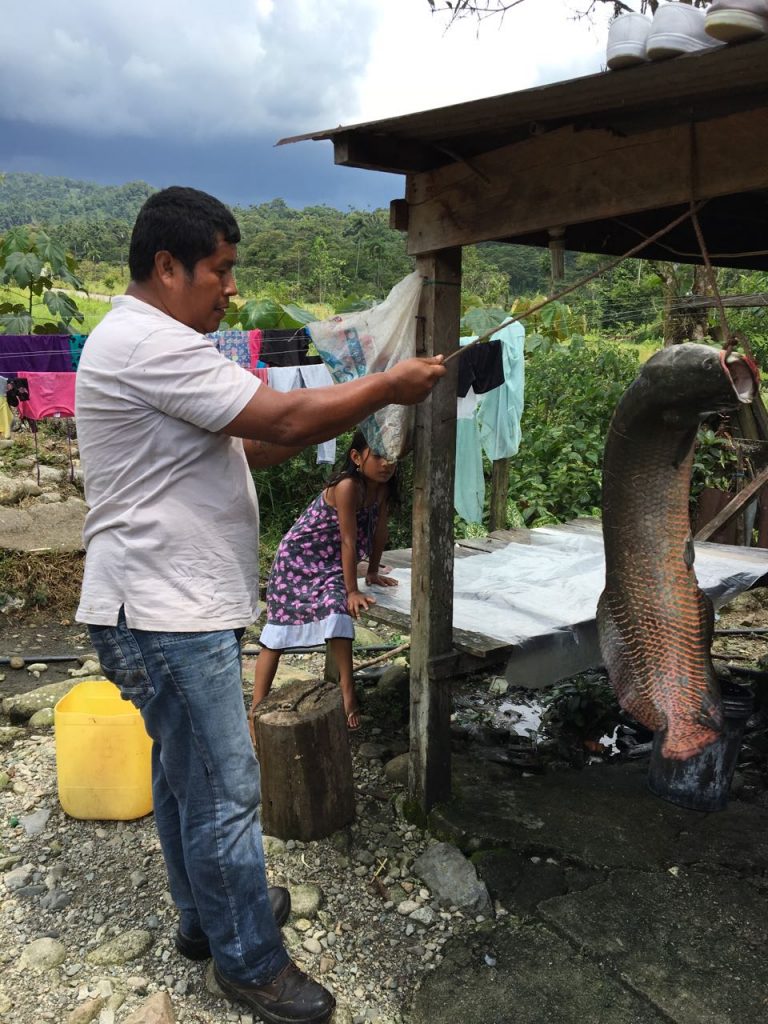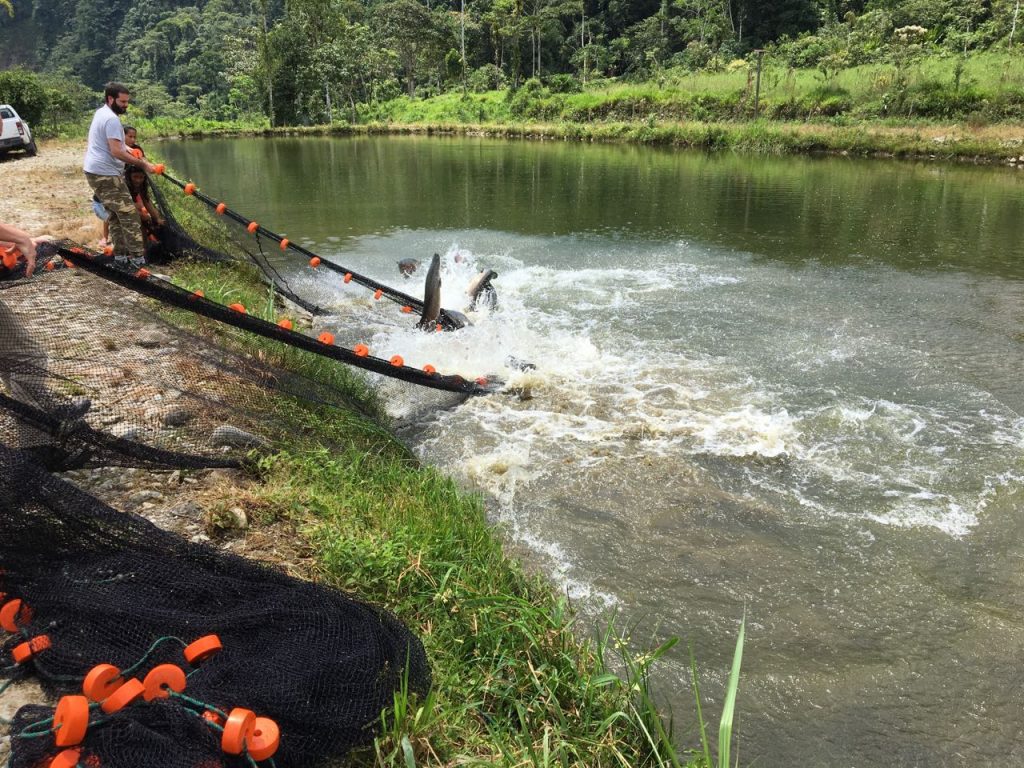By Iván Ulchur-Rota
“Was there enough for everyone?”, I asked Estefy Baldeón, chef and Canopy Bridge consultant, about the fish just grilled in a forest clearing on the banks of the Aguarico River in the Amazon. “Everyone ate,” she answered. “And they loved it.” After eating dinner around the fire, four chefs, the Canopy Bridge team and fifteen members of the local community were full and happy. The hungriest of the bunch even went for seconds. It’s what happens when paiche, Arapaima gigas, the largest fish in the Amazon, is on the menu. Now, raising this native fish and partnering with big-city chefs has become a creative and practical alternative in the fight against deforestation.
Dureno is a community of the A’i Cofan indigenous nation, located on the Aguarico River, in northeast Ecuador. Together with Canopy Bridge staff members, the chefs Juan Sebastián Pérez, from Quito restaurant Quitú, Enrique Sempere from The Market and José Sogues, from La Paraeta, traveled to take a closer look at the farming process. They all have included paiche in their menus, not only for its culinary value, but because of what it means for the communities that cultivate it, and their rainforest lands. “Paiche meat is as versatile as salmon,” says José Sogues, who is used to experimenting with fusion food. “Excellent quality and texture: over the grill, as barbacoa, the fillet would held together well.”

While paiche’s culinary qualities are yet to be fully explored, its environmental and social potential is undeniable. The profits made through paiche fish farming can help its producers self-manage their local economy while protecting the forest: it’s a commercial product that reinforces the conservation of the ecosystem. According to Roberto Aguinda —the A’i Cofan fish farmer who received the chefs and who promotes paiche around Ecuador— this fish reproduces easily inside the pools and grows almost a kilo a month.
The product that’s consumed in Quito is raised in three pools in the communities of Dureno, Sinangue and Chingual. While the paiche served to the chefs was fished in Chingual, in the other two pools the fish are still growing, as is their market. It is a slow (but steady) learning process for producers, distributors and chefs, but its viability is a motivation for all. For a presentation in Quito, for the event “Biodiversity Market”, organized by the Mauricio Acuña´s Patria restaurant , Aguinda made the value proposition clearly: while a head of cattle needs almost one hectare and a half to graze, in half a hectare you can raise up to 200 paiches – more protein, more income, and less deforestation… It just makes sense: fish farming is an option that may still take some time to take off, but that will benefit Ecuadorian cuisine, A’i Cofan communities and the environment.

Whether these initiatives succeed depends on how they adapt to local realities. While in Ecuador fish farming is just emerging as a viable alternative for conservation, Peru has a long history of conservation organizations supporting sustainable community management of wild fisheries in rainforest waters. Canopy Bridge and Forest Trends are working there in partnership with renowned Lima chef Pedro Miguel Schiaffino to bring high-value wild-caught paiche from these communities to new markets. And some Peruvian fish farms are already exporting to American grocery chains like Whole Foods. Each reality involves different strategies: in Colombia paiche is an endangered species, in Bolivia, instead, it is considered an invasive species. For the A’i Cofan communities of Sucumbios, fish farming protects the species and the environment. “It all depends on how it is managed,” explains Luis Suárez, director of Conservation International Ecuador. CI-Ecuador (a non-profit) supports efforts by A’i Cofan communities, as well as by other indigenous nationalities from the Amazon, to develop economic alternatives that reduce deforestation and improve local living standards.
“Now, the main challenge is to improve the distribution process so that the product upholds the quality that restaurants demand: that it is well sliced and that it is transported clean and fresh without the need to freeze it,” says Suárez. The A’i Cofan community is surely not alone in their efforts: organizations like CI-Ecuador and Canopy Bridge work to improve the supply line, keep an eye on production quality and generate enough stable income for producer communities.

Arapaima gigas is one of the over 2000 species of fish that inhabit the Amazon river. That is, 2000 potential alternatives to cattle and timber. In many restaurants in Quito, it’s already being served grilled and smoked.
At night, José Sogues tried the grilled paiche. “I had tried it one time before and I liked it. But that time was nothing like what I tried today with the A’i Cofan people,” he said. They ate it wrapped in wild culantro leaves from the forest, with yuca and sweet plantains on the side. “It was delicious,” says Estefy. “Many people were really hungry.” Still, there was enough for everyone to eat their fill.
This exchange was part of the Cumari-Rainforest to Table initiative #DeLaSelvaalaMesa, a partnership between leading chefs and partners like Canopy Bridge, Forest Trends and the Wildlife Conservation Society which promotes products like paiche and tucupi to protect the forest and support Amazonian communities.


